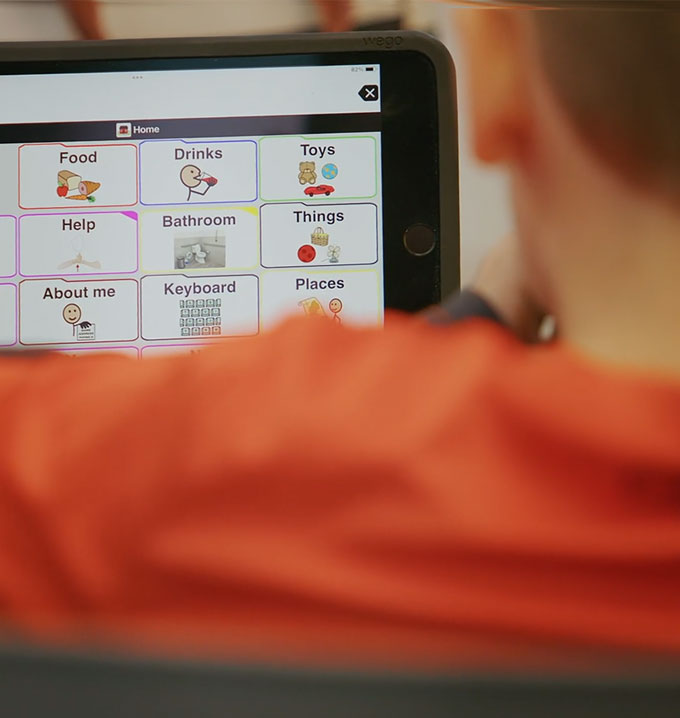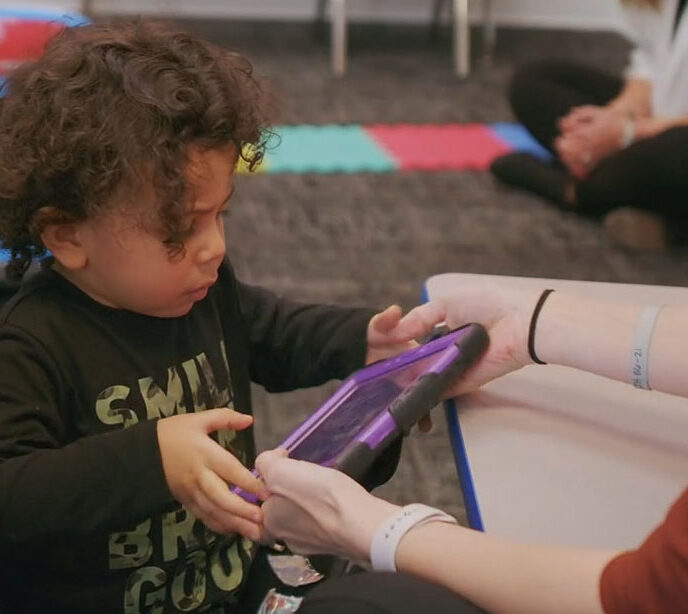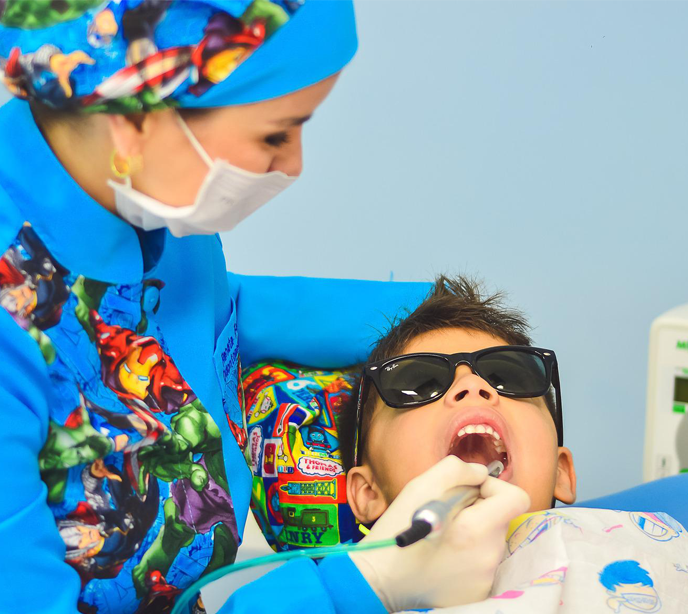Understanding & Using AAC Devices – Lighthouse Autism Center
Communication is a vital part of our daily lives. For those who have difficulty with vocal speech, Augmentative and Alternative Communication (AAC) can be a useful tool. AAC devices can help both children and adults with speech difficulties express themselves, connect with others, and improve their independence. Read this blog for a deep dive into this helpful communication support method.

Understanding AAC for Autism & Using AAC Devices
Communication is the foundation of human connection and interaction. However, it’s also one of the areas where autistic children tend to struggle most. If your child has difficulty with speech, finding a way to help them express themselves can make a huge difference in their lives. Augmentative and alternative communication (AAC) is a way for people who have difficulty with speech or lack the ability to speak entirely, to communicate their needs, wants, and desires. In this blog, we unpack what AAC is, the types of AAC devices you can use, their benefits, and more.
What Is AAC?
AAC refers to the wide range of systems and tools used to help people with speech challenges, and those who are unable to speak at all, communicate more effectively. This includes people with autism, brain trauma, Down syndrome, degenerative diseases, and other conditions. AAC helps these individuals connect and navigate a world where speech is often the primary way of communicating with others.
Not every autistic child communicates in the same way, and difficulties with speech can be more severe for some than others. For example, some autistic children may still communicate verbally but struggle with complex sentences or social language, while others may be completely non-verbal. So, AAC isn’t just about finding a replacement for speech; it’s about finding what works for each child and their unique capabilities.
To better understand AAC, it’s important to unpack what the terms “augmentative” and “alternative” mean in this context.
- Augmentative communication systems support or assist someone’s ability to speak.
- Alternative communication systems, on the other hand, provide an alternative to spoken language.
Different Types of AAC
The different types of AAC can be categorized into two broad groups: unaided and aided. Understanding the differences between these two categories can help you find the right communication support for your child.
Unaided AAC
Unaided AAC refers to a type of communication system or strategy that doesn’t use any additional tools or materials. Examples of unaided AAC include:
- Facial expressions: Using facial movements to express emotions.
- Gestures: Communicating through hand and body movements.
- Body language: Conveying information through posture and physical actions.
- Sign language: A structured form of communication using hand movements and facial expressions.
- Vocalizations: Non-word sounds used to communicate.
Aided AAC
Aided AAC is a communication system or strategy involving additional tools or materials to facilitate communication. These tools can range from simple picture cards to high-tech devices. Some common aided AAC tools include:
- Communication boards: Boards with images or symbols that users can point to.
- Choice cards: Simple cards that show options for activities, foods, or feelings that can help people who struggle with speech express their desires and preferences
- Speech-Generating Devices (SGDs): Electronic devices that produce spoken words when buttons or symbols are pressed, ranging from basic single-message units to advanced systems that generate full sentences.
- Mobile communication apps: Various mobile apps offer communication support tools, including text-to-speech and symbol-based communication.
The key is finding aided AAC tools that match your child’s comfort level, interests, and communication style. Some children might start with simple picture cards and gradually move to more complex devices as their needs and abilities change.
Aided AAC is where AAC devices come in.
What Is an AAC Device?
AAC devices are specific communication tools used when an individual is unable to express themselves using spoken or written language.
The Different Types of AAC Devices
There are two categories of AAC communication devices: Low-tech (non-electronic) and high-tech (electronic). Some common AAC devices that fall into these categories are:
Low-tech AAC devices
Symbol boards, alphabet boards, communication books, and choice cards. If the user is able to do so, they may select images, words, or phrases. If they have physical limitations, gestures, light pointers, gaze, or a head-mouth stick might also be used. They might also use another way to communicate yes or no, such as nodding their head as someone reads through the options available to them.
High-tech AAC devices
Speech-generating devices (SGDs) or voice output communication aids (VOCAs), devices with pre-programmed messages and apps on tablets and smartphones. How a user interacts with high-tech AAC devices varies greatly, depending on its capabilities and the user. For example, some SGDs are operated by hand or using eye-tracking technology.
Depending on the cause of the communication impairment, low-tech or high-tech devices may be better suited to address an individual’s needs than others. However, while some people may need either a low-tech or high-tech device most of the time, they may need a device they normally don’t use.
For example, someone using symbol boards may have difficulties communicating in a poorly lit room. Another person who uses a device like an iPad to communicate may be unable to do so if they are outdoors and caught in the rain. This is why it is important that people have access to both low- and high-tech AAC devices where possible.
Both low-tech and high-tech devices are further broken down into three categories, depending on the type of communication system they use. These three categories are:
Single-Meaning Pictures
A single image has a single meaning. Users are taught what each image means and how they can communicate by gesturing at the word or selecting it, depending on the type of AAC device. Some limitations of these systems are that they may require thousands of images before they can be used meaningfully or that it could be difficult for them to communicate more abstract words like “help,” “stop,” or “mine.”
Alphabet Systems
Alphabet systems require some level of literacy. Communication occurs when the user points at or selects each letter to spell out the word they are trying to communicate or chooses from complete words. An example of this would be words printed on cards or displayed on a digital device.
Semantic Compaction
Multiple images are used in a sequence to communicate. A single image has multiple meanings — but these meanings may change depending on the combination of symbols. Users are taught the meanings of each image and how to construct sequences with specific patterns that affect meaning.
The Benefits of AAC Devices for Autism and Other Speech-Impeding Conditions
For someone with autism, apraxia, traumatic brain injury, or other conditions that affect their speech and those who struggle with verbal or written communication, AAC devices can provide numerous benefits. These benefits can include:
- Empowering users to become independent
- Improving the user’s ability to connect with others
- Improving a user’s speech and written communication skills
- Improving a user’s overall quality of life by reducing negative factors in their life, such as stress, vulnerability, and loneliness.
How To Choose an AAC device
Even if you have the best intentions, going in without the requisite knowledge of AAC devices and systems may leave you with a poorly suited device — or one completely unfit for use. This is why it’s important to work with a professional to help you compare the types of AAC devices for autism support and determine which would best suit your child’s needs. Whether it’s a speech-language pathologist (SLP), an occupational therapist (OT), a psychologist, or another suitably qualified individual, they can help you choose the best solution that meets the needs of the individual.
Learn More About Our Approach to ABA Therapy
Whether or not your autistic child uses an AAC device, we can help them develop and reach their goals with ABA therapy. Take a look at our autism resources to help you better understand autism. You can also learn more about our Lighthouse Fusion® ABA therapy program to find out how we can help autistic children improve their outcomes.
Together, we can unlock your child’s potential
Related News

10/07/2025
PECS and Its Use in ABA Therapy – Lighthouse Autism Center
The picture exchange communication system, or PECS, is a teaching system that can help an autistic child or another individual with speech difficulties improve their communication skills. We take a look at PECS’ role in ABA therapy and unpack how it works. What Is the PECS System and How Is It Used In ABA Therapy? […]

08/13/2025
ABA Therapy Tips for Taking Your Autistic Child to the Dentist
Taking Your Autistic Child to the Dentist For any child, and even adults, a trip to the dentist can often be filled with anxiety, fear, and discomfort. For a autistic child, especially, these feelings can be even further heightened by sensitivities to noise, smell, and touch. To make this experience better for both the child […]

08/13/2025
Tips for House Hunting with Your Child on the Spectrum
Guidance for Families with Children with Autism when Moving Moving is always a stressful and complicated endeavor. But when you have a child on the autism spectrum, the thought of packing up your household and moving somewhere new can seem like a near-impossible task. Parents often worry that their children will get overwhelmed by this […]


